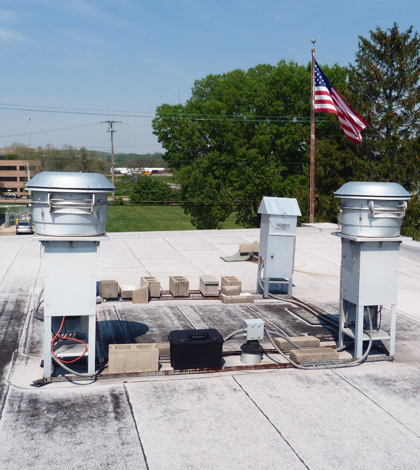A Look At Ohio EPA’s Extensive And Successful Air Monitoring Network

An air quality monitoring platform managed by the Regional Air Pollution Control Agency sits on the roof of an abandoned firehouse in Moraine, Ohio. The station is part of the Ohio EPA’s air monitoring network and includes sensors for tracking lead and particulate matter. (Credit: Daniel Kelly)
Since the passage of the Clean Air Act in 1970, Ohio has made significant strides in achieving good air quality. Part of the cleaner air the state now enjoys comes from shifts in manufacturing practices and the choices people have made to drive more fuel-efficient cars. But all of the achievements are owed in part to air monitoring efforts that have allowed environmental officials to track progress.
As part of its air quality maintenance work, the Ohio Environmental Protection Agency works with district offices, contract agencies and health departments around the state to oversee monitoring stations that keep track of six key pollutants: carbon monoxide, lead, nitrogen dioxide, ozone, particulate matter and sulfur dioxide. The monitoring network reports information in real time on AirOhio, the agency’s air monitoring website.
Data are published as they are received, about every 15 minutes, so that people can check their local air quality and know if they need to be more careful than usual. From an air quality management perspective, Ohioans can use the data to take steps to alleviate poor air quality. The air monitoring data can also serve as a first line of defense for larger-scale pollution events.

An air quality monitoring platform managed by the Regional Air Pollution Control Agency sits on the roof of a Sinclair Community College maintenance building in Dayton, Ohio. The station is part of the Ohio EPA’s air monitoring network and includes sensors to track ozone, particulate matter, pollen and mold. A weather station, tipping bucket rain gauge and solar radiation sensor also collect meteorological data. (Credit: Daniel Kelly)
“Ohio has one of the most extensive air monitoring networks in the United States,” said Dina Pierce, spokesperson with the Ohio EPA. “They’re (stations) located where you’ll find pollution and include a variety of equipment.”
Fluorescent analyzers use ultraviolet light to measure sulfur dioxide concentrations. Nitrogen compounds are tracked based on the wavelengths of light they produce when they react with oxygen. Carbon monoxide, produced through the burning of coal and other dirty substances, is measured using infrared light, while levels of lead are evaluated based on collection rates in filters.
The monitoring approaches used for the pollutants varies by location, says Pierce, with federal regulations often dictating where a site must go. Lead monitors, for example, are commonly deployed near factories that produce the pollutant as a byproduct of their processes. This is the case for a site maintained by the Cleveland Division of Air Quality that sits beside a facility owned by the Ferro Corporation Coatings company.

Brian Huxtable, an air pollution control specialist with the Regional Air Pollution Control Agency of Dayton, Ohio, inspects a weather station. (Credit: Daniel Kelly)
But the most common constituents that stations monitor are ozone and particulate matter because those are most closely linked with public health.
“Ozone – that’s the haze, or smog that includes nitrogen oxides, automobile exhaust and combustible materials. The heat aggravates it and creates ozone,” said Pierce. The most harmful, though, are levels of particulates, says Pierce. “The air quality index alerts are typically for ozone and particulates to let people with heart or lung issues limit their exposure.”
And for those who don’t have health concerns, the alerts are still useful because they can encourage air-friendly actions.
“It lets folks like me know to take steps like putting fuel in my car before 8 in the morning or after 6 in the evening, or combining trips,” said Pierce. “Or cutting the lawn later in the cooler part of the day.”
The network has also proven useful in responding to sudden poor air quality brought on by disasters, like plant explosions blasting large amounts of pollutants into the air.
“There was an explosion and fire at an oil refinery in Lima, and we brought in air monitors to see if people should stay home, or keep their windows shut,” said Pierce. “We were on the ground to help in an emergency. The network wasn’t designed for that, but it’s sort of a front line of defense.”
Top image: An air quality monitoring platform managed by the Regional Air Pollution Control Agency sits on the roof of an abandoned firehouse in Moraine, Ohio. The station is part of the Ohio EPA’s air monitoring network and includes sensors for tracking lead and particulate matter. (Credit: Daniel Kelly)




0 comments